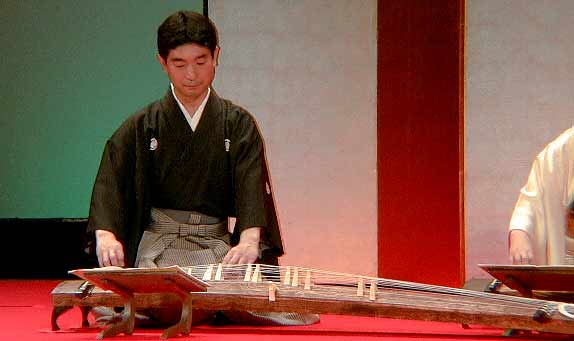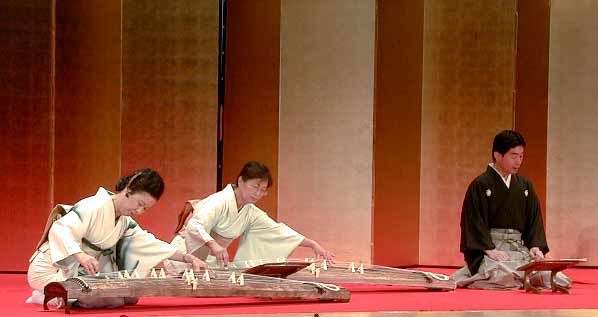All about Koto
j-views has been lucky enough to meet Mr. Katsumi Yanagisawa, who works by day in an electronics company in Tokyo, with state-of-the-art digital audio equipment. In the evenings and at weekends, he plays and teaches the koto, the traditional Japanese zither-like instrument (as shown below), the shamisen (a banjo-like instrument), and also sings traditional Japanese classical music. The contrast intrigued us, and so we asked a few questions.

j-views: Why choose the koto, rather than a Western instrument?
KY: I'm certainly not opposed to Western music. I enjoy music such as Brahms and Tchaikovsky, and I also enjoy a lot of Western popular music. For example, I have all of the Beatles albums. But I play the koto. Why? Well, I feel that hougaku (Japanese traditional music) is in my blood and is a part of me.
j-views: Actually, that's something I wanted to ask. Your mother teaches koto, and you didn't want to learn as a child, but now you play.
KY: I should explain that I was born into a family of traditional Japanese musicians. My mother had played koto since she was a girl. My grandfather and father were both shakuhachi [bamboo end-blown flute] players. And when they were younger, my mother and father used to perform together for NHK [the Japanese state broadcasting corporation]. Also, my mother had her own koto group and taught koto to her pupils. So hougaku was very natural to me, especially koto, and it was natural for me to learn.
But... nowadays, most koto players are women, and there aren't many male players, and so the koto is seen somewhat as a woman's instrument. So when I was in elementary school, I felt a little ashamed about playing, and I suddenly stopped studying. Conservative Japanese men don't like to be seen behaving like women, and I was a very conservative little boy at that time.
The koto world is very conservative, and I grew up in these conservative surroundings. Ironically, the conservatism of koto pushed me away.
j-views: Anything else?
KY: Well, I have to admit that there was a difference of attitude between my mother and myself. Of course, she was very serious in her attitude, and she wanted me to be as serious as her, and didn't make any allowances for the fact that I was just a little boy. Actually, it was quite difficult physically for me to keep up with her demands, and I became out of breath.
j-views: So what changed?
KY: In my university days, I was looking for a purpose to my life. I was asking questions like "What should I do?" or "What talents do I have?".
And what changed things for me was the party to celebrate the twentieth anniversary of my mother's koto group. Although I didn't actually start learning koto again, I did get involved with helping. At the party, some of the main members of the group suggested that I should take up the koto again.
And then it dawned on me that there was no-one really who could take over my teacher's -- my mother's -- style of playing. If I didn't take it up, it would be lost forever. I should explain that my teacher's style is rather different from the mainstream style. And that's what decided me to inherit my teacher's style.
j-views: What does music in general, and koto in particular, mean to you?
KY: One of the main questions I ask is "what is the true koto sound"? Right now, there's something of a boom in dentou-geinou [Japanese traditional entertainment]. This includes hougaku and koto, and a lot of people are interested. But many koto players think that either playing modern pieces by contemporary composers, or playing traditional Japanese folk songs, is the way to introduce the conservative koto to the modern public. Personally, I don't agree. Of course, it is worth introducing it in this way to the public, but it's not essential. To me, the most important thing for a koto player is to play with what I call the "true koto sound". This is a mellow sound, in contrast to the belief of most modern koto players that the "true sound" is a rather strong, explosive sound. I am completely against this belief.
Music has the power to touch people in their hearts or to move their emotions. Quite apart from the technical craftsman-like mastery, koto playing must also fit this definition of music. Of course, skill and technique must be present, but there must be more than mere technical skill.
The true koto sound should be understandable by anyone; not just by Japanese or Asians, but by Europeans and Americans as well. If koto players only seek to please the current contemporary tastes at the expense of the true koto sound, then audiences will desert the koto. And that would be a tragedy.
I love koto playing that can tug at your heartstrings, and I want to play with my teacher's mellow sound, which can be passed on to the next generation.
I have this dream that our koto style will be accepted worldwide, and that we will some day see koto players from outside Japan playing with our style.

Mr. Yanagisawa is at the right of this picture, singing in the traditional Japanese fashion. His teacher is at the left (pictures by Hugh Ashton 27 May, 2001 at the Edo-Tokyo Museum Concert Hall, Tokyo). We hope that some time soon we will be able to provide a sound clip to illustrate Mr. Yanagisawa's thoughts. In the meantime, he will be happy to answer questions. Please address any questions to sou@j-views.com.